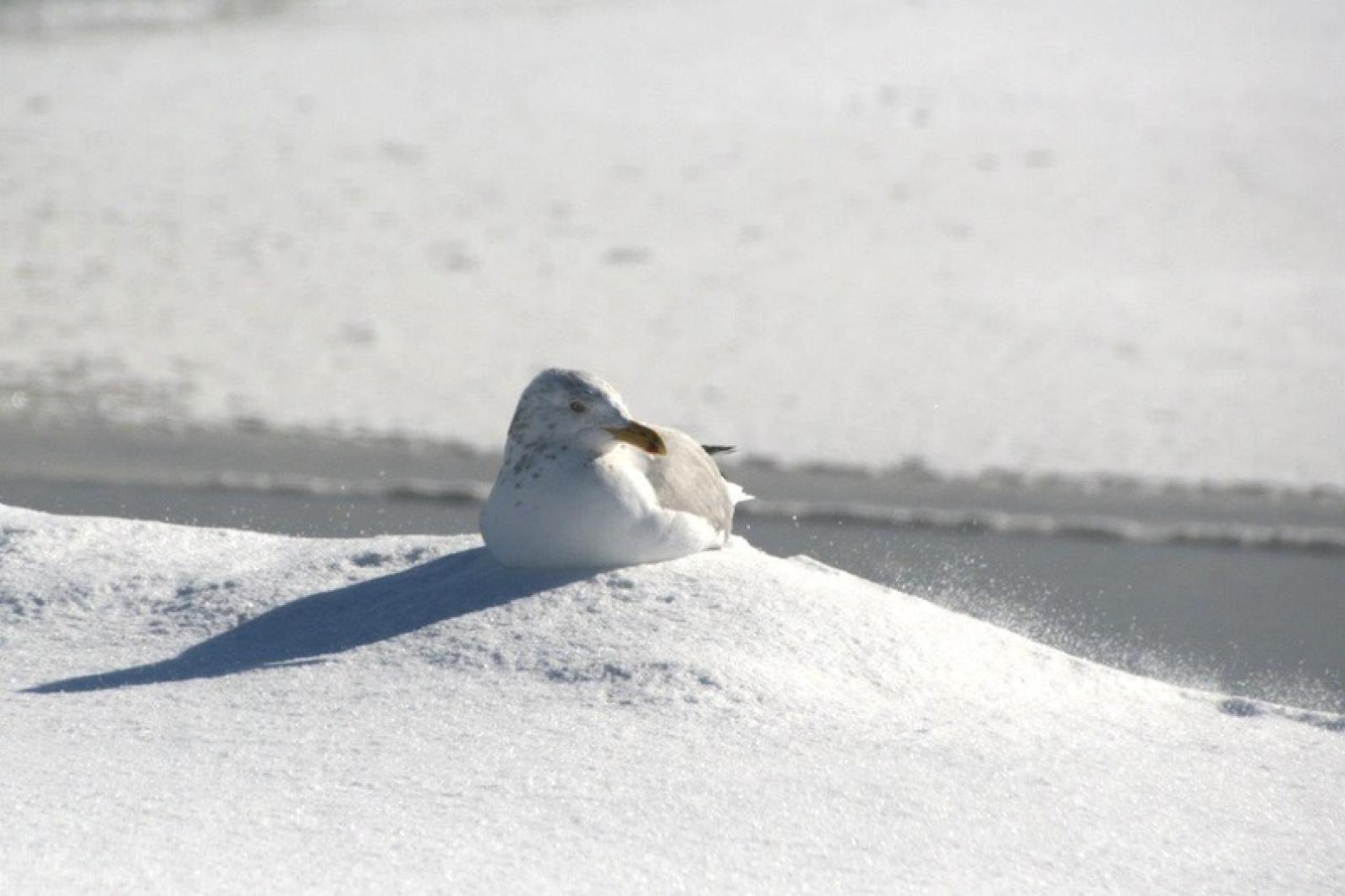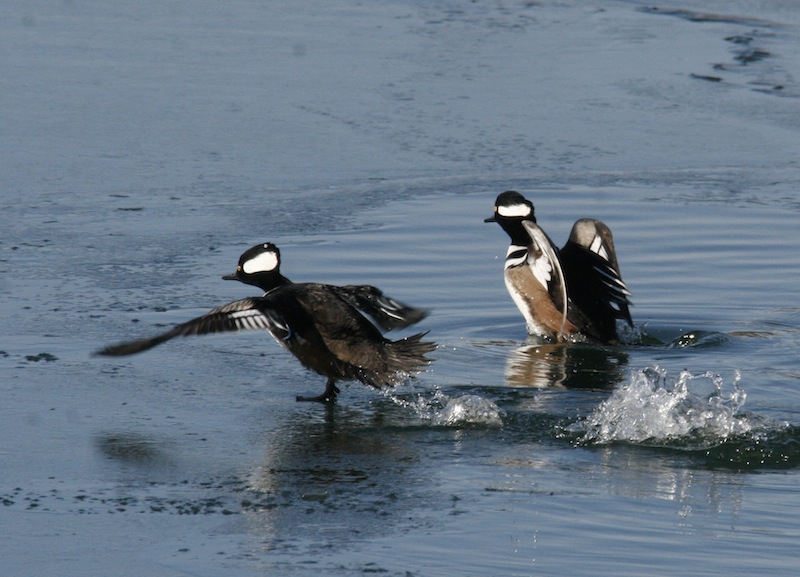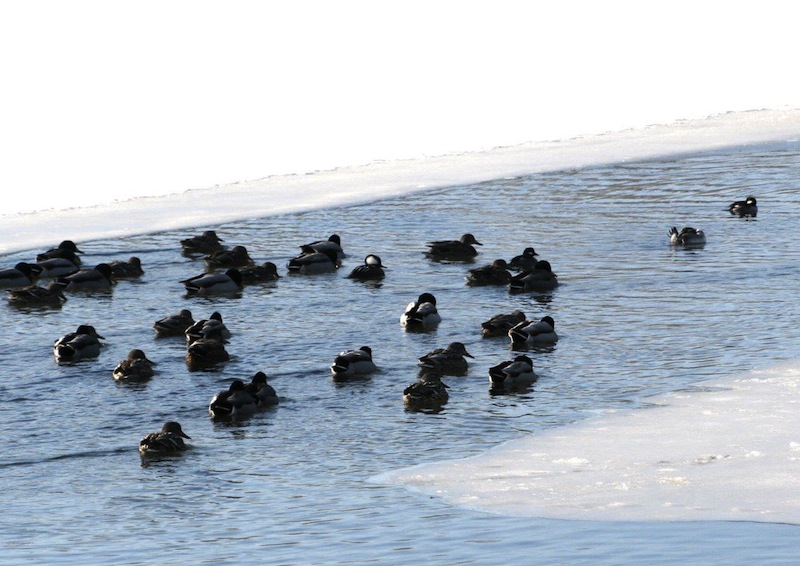Frigid temperatures and more than a month of snow cover have put the Island bird population to the test this winter. Many species are now getting by with the help of bird feeders, while others are branching out into different types of food. And one species in particular, the barn owl, has seen its population ravaged by the perfect storm of harsh winter conditions.
“Birds are outdoor wildlife — they can manage it,” said Suzan Bellincampi, director of the Felix Neck Wildlife Sanctuary. “But the harsh conditions can have an effect on them, their feathers and down, sometimes it’s not enough.”
Since the start of the year, there have been 21 days when temperatures never rose above freezing, according to data from the National Weather Service station in Edgartown. The past two weeks have been particularly icy, with 10 sub-freezing days.
Most birds that winter on the Island or live here year-round are equipped to handle the cold. They fluff up their feathers to trap air as insulation, and many birds roost in clusters at night to stave off the chill. Some species find tree cavities to take shelter in.
In order to make it through a tough winter the birds must consume more calories, since they burn more while trying to stay warm. Finding food has become a challenge due to the frozen waterways and snow-covered fields. Weather data shows that there has been at least nine inches of snow on the ground for the entire month of February.
“Birds generally need the open ground for feeding and scratching,” Ms. Bellincampi said.
Predator species such as owls need the open ground to spot and hunt prey. Mice and voles are now hidden beneath a layer of snow. Certain species, like the screech owl, are better equipped to hunt prey like the whitefooted mouse, which occasionally comes above the snowpack to feed in trees and bushes.
But the barn owl relies primarily on the meadow vole, and the absence of prey combined with the extreme temperatures has ravaged the Island population. Barn owls are at the northern limits of their breeding range on the Vineyard and on Nantucket. Felix Neck has had a nesting pair of barn owls living in a box off its main building since 2006. The pair is featured on the sanctuary’s owl cam, which has drawn more than 50,000 views since its launch. But the cam has captured unhappy news — the female died last week and the male has not been seen in more than 10 days, Ms. Bellincampi said. “People have been very concerned,” she said, noting the large number of viewers on the cam.
Old age likely played a role in the female’s death. Most barn owls do not live longer than five years. “These barn owls have been at Felix Neck since I started,” Ms. Bellincampi said. “They’ve been there since the beginning, and now they’re not.”
Naturalist Gus Ben David said there were between 25 and 35 breeding pairs of barn owls on the Vineyard before winter. But many have already been found dead, including the pair on his own property. He said he expects a mortality rate of about 95 per cent.
The last time the Vineyard experienced a winter of comparable severity was in 2005. That year, too, the barn owl population “knocked right down,” Mr. Ben David said.
“When this happened in 2005, we almost had 100 per cent mortality,” he said. “But we had a couple of pairs that did survive.” Barn owl survival would ultimately depend on which pairs were living in areas frequented by whitefooted mice or by rats — so they could get by on secondary sources of prey.
“This is all a natural process, this is nature’s way of keeping the gene pool strong,” Mr. Ben David said. He said the numbers typically would rebound as young birds in the south were pushed farther north by growing populations.
Still, sometimes the gene pool gets a little more help. This has been particularly true of songbirds and other species that frequent bird feeders.
“More birds, certainly, are depending on those feeders,” said ecological consultant Robert Culbert. The common feeder species — chickadees, cardinals, white-throated sparrows — are eating more seed, and birds not normally seen at feeders are making appearances.
“You’ll definitely find birds that can manage by shifting gears,” said Lanny McDowell, an avian photographer. “The Carolina wren will at least come around and look at the feeders. Their bills are not made for opening seeds, but they can scarf up the little stuff.”
Both Granite Hardware in Edgartown and SBS in Vineyard Haven reported increased sales of bird seed this year. “Normally in the wintertime we sell a lot of bird seed,” said Audrey Davenport at Granite. “But this year we’ve been selling a lot more.”
In some cases, the seed and nut eaters are turning to the suet that people put out. Susan Whiting, bird columnist for the Gazette, said Tuesday that she has seen blue jays, titmice, and even chickadees eating suet.
Mr. McDowell concurred. “It’s not like a bird ordinarily finds a chunk of beef fat in the wild,” he said. “But once they get the idea that there’s a lot of nourishment there . . .”
Mr. Culbert and Ms. Bellincampi said their advice for people who started feeding birds this winter is to continue until spring.
“The birds are really dependent on it,” Mr. Culbert said. Ms. Bellincampi said making sure the feathered visitors have fresh water to drink and bathe in is also important.
For birds that spend most of their lives on the water, the largest concern has been the solid ice in harbors and ponds. Ms. Bellincampi said she has received a number of calls about ducks that are out of their element and forced to take to land to look for food. Most people believe the duck is injured, she said.
“Typically, it’s not,” she said. “There’s not a lot of open water, and it’s exhausted. They’re really made for swimming, not walking, so when they’re on land they look like they’re struggling.”
“We just had one that was brought removed [from land], warmed up, given food and water, and then released,” she continued. If a bird is truly injured, it would need to go to a professional rehabilitator, such as Mr. Ben David.
The water birds — mallards and Canada geese in particular — are also showing up at bird feeders, where they can eat seed from the ground. One man recently called Felix Neck about a Canada goose in his yard. He had been feeding the goose. Ms. Bellincampi warned that he might not be able to rid himself of the bird come springtime.
“He said I can’t in good conscience not feed it,” she recounted. “People get emotional about it.” Calls to Felix Neck, and to Ms. Bellincampi during off hours, have increased in the past two weeks as winter conditions worsened.
Even Mr. Ben David has been helping out one particular bird: an immature black-crowned night heron that arrived at his pond last year. The enterprising heron ate its way through Mr. Ben David’s koi and goldfish population, then stuck around with the resident mallards because the pond does not ice over in the winter (Mr. Ben David runs well water through it). The heron now gets frozen minnows, and likely would die without the supplements.
“I’m breaking my own rules,” he said.
“People want to help,” Ms. Bellincampi said. “The drive to save wildlife and help animals is really strong.”
But she added that just this week, she had started to notice more birds singing in the morning, perhaps a sign that spring is on the way.
“The osprey could be back in as few as three to four weeks,” she said.








Comments (5)
Comments
Comment policy »